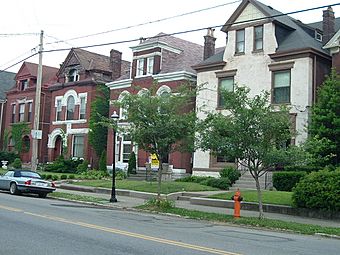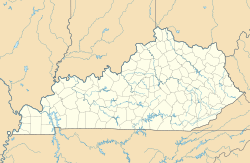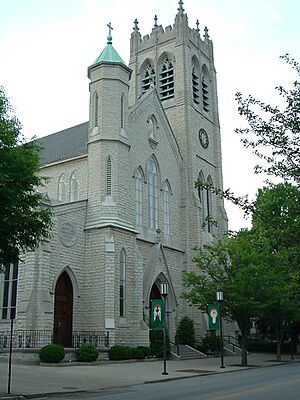Limerick, Louisville facts for kids
|
Limerick Historic District
|
|

Large mansion house built by "lace curtain" Irish in the 1890s
|
|
| Location | Between Breckinridge and Oak, 5th and 8th St., Louisville, Kentucky |
|---|---|
| Area | 47 acres (19 ha) |
| Built | 1860 |
| Architectural style | Queen Anne, Romanesque, Victorian |
| NRHP reference No. | 78001360 (original) 83003715 (increase) |
Quick facts for kids Significant dates |
|
| Added to NRHP | September 13, 1978 |
| Boundary increase | December 23, 1983 |
Limerick is a historic neighborhood located about a mile south of downtown Louisville, Kentucky, in the USA. It's known for its rich history, especially its connections to Irish immigrants and the railroad.
Contents
A Look Back: Limerick's Beginnings
Limerick started in the 1860s. It was built for people who worked at the Louisville and Nashville Railroad freight yard. The neighborhood got its name because most of its first residents came from County Limerick in Ireland.
The St. Louis Bertrand Catholic Church was a very important building in the new neighborhood. Limerick was one of the first places where working-class people lived southwest of downtown Louisville. This trend of people living in that area continues even today.
Homes and People in Early Limerick
Many Irish immigrants who worked hard lived in simple shotgun houses. These houses were long and narrow. Some African American families also lived in the alleyways behind these homes.
Wealthier Irish families, sometimes called "lace curtain Irish", built bigger mansion houses. These larger homes were often found on St. Catherine Street.
The Irish Catholic community was very strong in Limerick. From 1872 to 1918, a special St Patrick's Day parade marched from the church to Broadway every year. However, as many railroad jobs moved away, many Irish families also started to move to South Louisville.
Firefighters and Community Safety
On October 7, 1871, the Louisville Steam Engine Co. 7 was created. Its job was to protect the "southern suburbs" of Louisville from fires. Their firehouse at 821 S. 6th Street is very old. It is the oldest fire station in the U.S. that has been used continuously.
Education and African American History
As Irish families moved out, African American families moved from the alleyways into the empty shotgun houses. In 1873, Louisville Central Public School opened. This was Kentucky's first public school for African Americans. It was located at 6th and Kentucky Streets.
The school later changed its name to Simmons College. Then it became Municipal College for Negros. This was a "colored" campus of the University of Louisville. Today, the school is working to get its old campus back. It is now officially known as Simmons College of Kentucky.
Baseball in Limerick
Starting around 1874, Limerick was home to two baseball fields. Both were called Eclipse Park. They were located at 7th and Kentucky streets, across from each other. These parks were the home field for Louisville's major league team, the Louisville Colonels. The team was originally called the Louisville Eclipse. They played there from 1882 until the team stopped playing in 1899.
A famous baseball player named Honus Wagner played his first major league game here. This happened on July 19, 1897.
Local News
The news weekly Kentucky Irish American was published from Limerick for almost seventy years. It started in 1898.
Protecting Limerick's Past
Today, Limerick is a special place called a historic preservation district. This means that its historic buildings and character are protected. It helps keep the neighborhood looking like it did in the past.
The district is bordered by Breckinridge Street to the north and 5th Street to the east. Oak Street is its southern border, and the CSX railroad tracks are to the west. South of Oak Street, the eastern border changes to 7th Street until it crosses the railroad tracks.
Limerick's Population Today
In the year 2000, Limerick had 1,448 people living there. About 56.5% of the people were Black, and 37.7% were White. Other groups made up 3.8%, and 2% were Hispanic.
About 17.3% of the people had graduated from college. About 21.2% did not have a high school degree. There were more males than females, with 63.7% males and 46.3% females.




